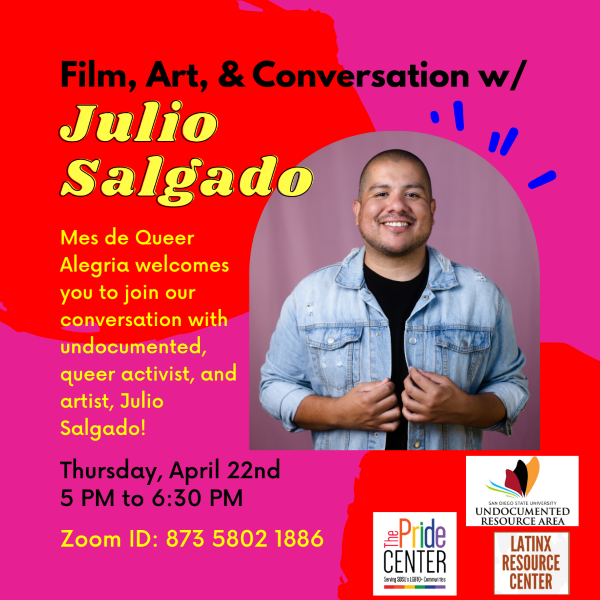Julio Salgado an undocumented queer activist returned to San Diego State to speak at the SDSU Pride Center and share his work since his previous campus visit.
Salgado said he draws for himself first and hopes to inspire others through his work.
“A lot of people started getting to know my artwork when a lot of us were trying to push for the DREAM Act,” Salgado said. The DREAM Act is the acronym for the “Development, Relief, and Education for Alien Minors Act.”
Family issues made it so Salgado’s family had to stay in the United States, causing Salgado to miss his sixth-grade graduation.
“I remember being super bummed out like ‘I don’t want to be here,’” Salgado said.
As a pre-teen navigating a new culture and the American immigrant experience, Salgado realized he had a knack for art. “At a young age, I was encouraged to participate in art,” Salgado said. He was always the kid drawing in class; every day he would draw and improve himself, driven and inspired by his teachers and Frida Kahlo.
His supportive family was his rock, encouraging and helping him in any way that they could.
When he speaks of them, he mentions his late Chicho. “I consider him my queer angel,” Salgado said. An undocumented gay immigrant living through the AIDS crisis in the early 90s, Salgado sees his uncle as resilient and inspiring.
“My dear Chicho was that person in my family, who opened the conversation to be able to talk about what a queer was, what a gay man was,” Salgado said.
The artist is currently working on art to pay tribute not only to his uncle but to members of the queer community lost in the 90s.
Encouraged to attend art school by his teachers, luck had it in 2001, the year he graduated, AB540 was passed, allowing undocumented students to apply for in-state tuition.
At $11 a unit at a community college, Salgado focused on studying art. Salgado remembers his days at Long Beach City College taking art classes, “I hated it, to me, it was so boring. The history I was learning was all white, I didn’t see myself reflecting on it,” Salgado said.
With school expenses piling up, Salgado realized that finding a steady job as an artist after graduation would be tricky. He quickly got involved with the newspaper, fell in love with Journalism and changed his major.
Taking a shot, Salgado reached out to Gustavo Arellano after reading one of his stories, encouraging students not to be intimidated and to take chances when it comes to reaching out to people, “Sometimes people will not reply, don’t get offended,” Salgado said, “but reach out to the folks you admire or the work that’s inspiring you.”
Due to his tenacity, Salgado has gotten the chance to work with so many of the artists he’s admired for years, “You’ll be surprised who responds to you.” He emphasizes that mentors are essential and he tries his best to mentor students and leads them in the right direction.
He transferred to Cal State Long Beach and joined the newspaper. Out of a desire to draw and express his creativity, Salgado and a few friends started their own magazine, “El Reflejo.”
“We would throw parties on the weekend, charge our friends and print these issues,” Salgado said. The community invested in this talent and his first do-it-himself journalism act was a success.
In 2010, leading up to the passing of the DREAM Act, a picture of five undocumented students in caps and gowns, inspired Salgado to document the Dreamer experience through art.
This “Undocumented and Unafraid” movement connected to Salgado as undocumented LGBTQ people started to become more visible.
“At that time, you have to understand that there were a lot of religious folks, (that were) down for immigration and reforms, but (they) don’t talk about the gay stuff,” Salgado said. “Then on the other side, you had (the) LGBTQ community who only wanted to talk about gay marriage and the military, but (were) not talking about the fact that queer and trans people were in detention centers.”
He started drawing images of folks coming out as queer and undocumented, reaching out through Facebook, asking them to send him a photo and their views on being undocumented.
“It was important to put a face to the people who were doing the work,” Salgado said. “I wanted to show the different experiences.”One piece of work could not speak for the entire undocumented community, so Salgado tried to make these pieces a three-dimensional narrative. In 2013, he was featured on a billboard for Pride Month displaying his “undocu-queer” artwork for people to see.
Salgado highlighted the importance of how people may not see eye-to-eye these days in the face of changing narratives, “We have to be ready to have that conversation.”
Since then, his work and stories have hit the mainstream. Salgado has been getting involved with the Hollywood scene with his art appearing in many different shows.
“We all watch TV, Hollywood has such an influence on the way the other is seen (and) that it’s important we tell those stories right,” Salgado said.
As a member of the organization “Center for Cultural Power,” Salgado took his own experience of apprenticeship and created “The Disruptors”, a fellowship that connects up-and-coming writers who want to write for TV with people working in the industry.
A truly passionate artist, the appreciation for his art is what inspires him to continue moving forward. He was recently featured in an exhibit called “¡Printing the Revolution!” at the Smithsonian, which featured artists of the Chicano Movement.
You can learn more about Salgado in his short film “My Name Is Julio: A Short Film by his Best Friend Jesús Iñiguez” on YouTube.







